ANNONA CRASSIFLORA AND ANNONA TOMENTOSA
NOME POPULAR: Ariticum, Marolo for A. crassiflora; Ariticum de Moita and Marolinho do Campo for A. tomentosa.
ANNONACEAE
|
Ariticum de Moita (A. tomentosa)
|
Marolo (A. crassiflora) |
INDIGENOUS NAME: The indigenous name is "Ariticum", comes from the Tupi and means "soft fuit" another name used is "Marolo" with expression which indicates the phraseology "head-to-black."
Origin: Both Ariticum of the bush as Marolo native of Brazilian savannas and its distribution is discontinuous, appearing in the open field, in the close to shrubby trees and closed shrubs where the vegetation is more dense, occurs from Goiás and Tocantins to the state of São Paulo and Mato Grosso do Sul, Brazil.
Characteristics:
The tree of Marolo grows to 10 meters (33 feet), has
crooked trunk of
Planted in the site of Frutas Raras: Ariticum de Moita was planted in February 2001 and Marolo was planted in October 2001. Both species flower since 2005 and are not fruiting yet.
Tips for cultivation: A subtropical plant, resistant to frosts to -3°C (27°F), can be grown throughout the country, at any altitude; adapts to any soil that is sandy and well drains the water from rain.
Propagation:
Seeds are dormant when dry, when once planted, will germinate in
Planting:
The Marcolo should be
planted in full sun in a space of 6 x
Cultivating: Make
only form pruning of the crown and remove branches that were grown from the
base of the trunk in case of Marolo which is a
tree,
while
the clump of
Ariticum de Moita
should grow without any interference.
Fertilize with organic compost, can be
Uses: The fruit is of excellent taste and fragrance for the consumer in-natura.
Flowering time in the site of Frutas Raras: November to January.
Fruting time in the site of Frutas Raras: March to May.
BUY THE BOOK “COLECIONANDO FRUTAS”
Back to the seedlist (English) or back to Annonaceae (Portuguese)

